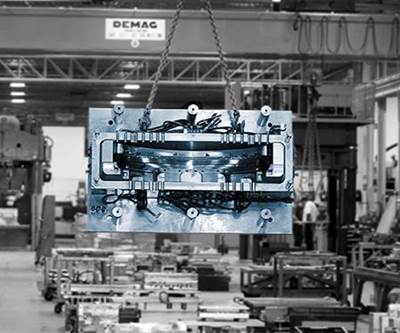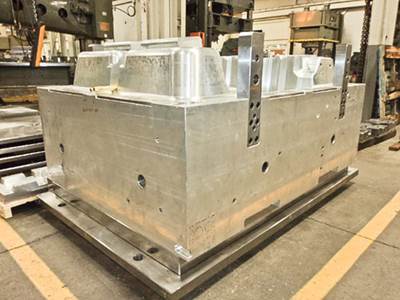Technical and Financial Advantages of Aluminum Tooling Vs. Steel Tooling
When OEMs and their key Tier suppliers begin to take a look at new ways to take costs out of their operations, will you be ready when the suggestion comes along for an aluminum tool?
There are sound technical and economic reasons why aluminum tooling is a great choice for numerous automotive applications. However, if that’s the case, why hasn’t aluminum tooling seen more widespread usage in recent years? It’s a mature technology that has been in use for high volume applications for years but remains unutilized with many processors.
Yet, for those OEMs who’ve studied it, the processors who’ve adapted their operations to realize the 30 to 50% cycle time advantages that result from an aluminum tool and the mold builders who know how to design and build high quality aluminum tools, it’s all good business.
Here’s a stark fact: In just about any medium-sized or large-part application, an aluminum tool will be the chief driver of manufacturing productivity and its usage will guarantee a lower piece part cost. Every time.
Aluminum tooling can offer distinct advantages. Pictured here a tool made by Unique Tool and Gauge for a front wheel well.
What About the High Cost of Aluminum?
We hear the complaints that aluminum is much too expensive versus P20 steel. In fact, 7000 series aluminum grades might be three to five times more expensive than P20 steel. While that’s true, an aluminum tool will be typically 1/3 the weight of a steel tool, so much of the cost advantage P20 steel has is mitigated. The tool savings for aluminum tool construction through machining efficiencies can range anywhere from 5 to 15%.
There are additional tool cost savings due to reduced mold build and repair time. For example, tools that have more mechanisms and have more depth will have more savings in aluminum versus P20, as machining, spotting, drilling and benching will require less time. Also, the higher electrical conductivity of aluminum, along with its lower melting point as compared to steel, enables the use of EDM at a rate four to five times higher than steel.
The converse of this is that tools that are “cut and ship” which are flat, relatively low- profile parts with little build hours due to lack of mechanics will have less of a cost savings.
To summarize, lead times in mold production, whether in steel or aluminum, are a direct relation to build hours on a production tool. Therefore, if tool build hours are reduced through efficiency, whether by material selection or by other means, lead times will be reduced as well. If a steel tool, for example, takes 4000 hours and 18 weeks to complete, then a tool for the same part built using aluminum should reasonably take 3400 to 3600 hours and between 15 to 16 weeks to complete. This represents a 10 to 15 percent reduction in both build hours and lead time. This comparison is based on our nearly 15 years of experience.
What About Cost Reductions in Actual Production Using an Aluminum Tool?
Any discussion of reduced costs using an aluminum tool needs to begin with cycle time reduction. As an example, a tool running 75,000 shots per year with a steel tool running a 50 sec cycle would need to run 250 days per year producing 300 shots per day.
That same application running in an aluminum tool would have a substantially faster cycle time. We’ll use a modest 30% cycle time reduction, recognizing that greater cycle time reduction would usually be the case. In our example, that same part would now require a 38 second cycle, which equates to a production run of 192 days per year. This equates to approximately 1400 hours saved, which equates to a substantial reduction in production costs and overhead or put another way, 175 extra eight-hour shifts of freed-up capacity.
Additional savings are possible, as experience has shown us that aluminum tools allow for reduced clamp tonnage. Smaller injection molding machines equal cost reduction. The dramatic reduction in tool weight also results in reduced wear and tear on equipment like cranes and injection machines, which equates to lower burden rates and lower overall piece part pricing.
What Technical Advantages Do You Get with an Aluminum Tool?
In addition to cycle time reduction and reductions in overhead costs, there is a demonstrated improvement in part dimensional stability, or flatness. The reason for this is that the temperature variances in the tool are minimal, and the part itself is measurably cooler upon ejection—closer in state to a fully cured part.
Injection pressure requirements affect both part economics and part quality. Of course, smaller molding machines are more economical, but there’s an additional benefit to aluminum, as our key customers tell us that there is less pressure required to fill an aluminum mold. The reason is that there is a rapid transfer of heat from the resin to the molding surface, instead of the resin taking on the lower temperature of the steel prior to the heat transfer to the mold. This creates a thinner “skin” of set plastic on the molding surface. If a part, for example is 2-mm thick, and the steel gives a 0.25-mm thick skin, the fountain effect of the resin flow leaves 1.5 mm for the plastic to pass through. If that same part is molded in aluminum, the skin will be about 0.1 mm thick, leaving around 1.9 mm for the flow. Less restriction in the tool means less injection pressure that’s required.
Aluminum tooling is a proven, robust technology to mold high-quality automotive parts in just about any volume, and at a piece part cost that P20 steel just can’t match. It’s time for molders and moldmakers to take another, more serious look at aluminum tooling . . . before our OEM and Tier customers do it for us.
About the Author: Darcy King is president & CEO of Unique Tool and Gauge Inc. Windsor, ON. Unique Tool and Gauge has years of experience successfully building aluminum tools for automotive applications for several OEMs and Tier suppliers, with production runs of up to 2.3 million shots on the same mold.
Related Content
PEEK for Monolayer E-Motor Magnet Wire Insulation
Solvay’s KetaSpire KT-857 PEEK extrusion compound eliminates adhesion and sustainability constraints of conventional PEEK or enamel insulation processes.
Read MoreAtop the Plastics Pyramid
Allegheny Performance Plastics specializes in molding parts from high-temperature resins for demanding applications as part of its mission to take on jobs ‘no one else does.’
Read MoreNeste, Borealis and Covestro Plan to Make Polycarbonate From Recycled Tires
Companies announced agreement that will use advanced recycling to convert old tires into new PC-suitable for automotive applications.
Read MoreNew CRM Streamlines Quoting for Automotive Molder
Eliminating the need to contact each supplier for every individual quote, a new CRM for automotive supplier Axiom Group tracks past quotes as well as industry history to generate fast, reliable RFQs and more.
Read MoreRead Next
What’s the True Cost of Buying A ‘Low-Cost’ Mold Overseas?
The head of a Canadian moldmaking company exposes the limitations of focusing solely on initial purchase cost when considering mold sourcing in China.
Read MoreLargest Aluminum Injection Mold Ever
Unique Tool & Gauge, Windsor, Ont. (unique-tool.com), completed a production injection mold machined from the largest block of tooling-grade aluminum ever forged.
Read MoreProduction Aluminum Tooling: What's Holding You Back?
It might be time to pursue aluminum molds in applications where traditional P20 steel has been specified without giving serious thought to any alternative.
Read More


























